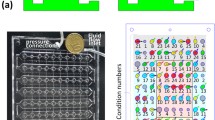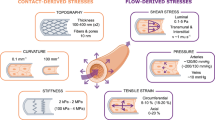Abstract
Introduction
Endothelial cells (ECs) morphology strongly depends on the imposed mechanical stimuli. These mechanical stimuli include wall shear stress (WSS) and biaxial cyclic stretches (CS). Under combined loading, the effect of CS is not as simple as pure CS. The present study investigates the morphological response of ECs to the realistic mechanical stimuli.
Methods
The cell population is theoretically studied using our previous validated model. The mechanical stimuli on ECs are described using four parameters; WSS magnitude (0 to 2.0 Pa), WSS angle (− 50° to 50°), and biaxial CS in two perpendicular directions (0 to 10%). The morphology of ECs is reported using four parameters; average shape index (SI) and orientation angle (OA) of the cell population as well as the standard deviation (SD) of SI and OA as measures for scattering of cells’ SI and OA from these average values.
Results
A new effective strain ratio (ESR) is defined as the ratio of the undesirable CS to the desirable one. The obtained results of the model, illustrated that the SI and OA of cells increase with absolute value of ESR. In addition, the scattering in the SI of cells decreases with the absolute value of ESR, which means that the cell shapes become more regular. It is shown that the angular irregularity of cells increases at higher ESR values.
Conclusions
The results indicated that, the defined ESR is a stand-alone parameter for describing the realistic mechanical loading on the ECs and their morphological response.








Similar content being viewed by others
References
Bernardi, L., C. Giampietro, V. Marina, M. Genta, E. Mazza, and A. Ferrari. Adaptive reorientation of endothelial collectives in response to strain. Integr. Biol. 10:527–538, 2018.
Breen, L. T., P. E. McHugh, and B. P. Murphy. Multi-axial mechanical stimulation of HUVECs demonstrates that combined loading is not equivalent to the superposition of individual wall shear stress and tensile hoop stress components. J. Biomech. Eng. 131:081001, 2009.
Campbell, J. H., and G. R. Campbell. The cell biology of atherosclerosis-new developments. Aust. N. Z. J. Med. 27:497–500, 1997.
Choi, G., C. P. Cheng, N. M. Wilson, and C. A. Taylor. Methods for quantifying three-dimensional deformation of arteries due to pulsatile and nonpulsatile forces: implications for the design of stents and stent grafts. Ann. Biomed. Eng. 37:14–33, 2009.
Choi, G., G. Xiong, C. P. Cheng, and C. A. Taylor. Methods for characterizing human coronary artery deformation from cardiac-gated computed tomography data. IEEE Trans. Biomed. Eng. 61:2582–2592, 2014.
Choi, G., J. Chen, J. Carroll, and C. P. Cheng. Handbook of Vascular Motion. New York: Elsevier, pp. 87–116, 2019.
Cucina, A., A. V. Sterpetti, G. Pupelis, A. Fragale, S. Lepidi, A. Cavallaro, Q. Giustiniani, and L. S. D’Angelo. Shear stress induces changes in the morphology and cytoskeleton organisation of arterial endothelial cells. Eur. J. Vasc. Endovasc. Surg. 9:86–92, 1995.
Cunningham, K. S., and A. I. Gotlieb. The role of shear stress in the pathogenesis of atherosclerosis. Lab. Invest. 85:9–23, 2005.
Ding, Z., and M. H. Friedman. Dynamics of human coronary arterial motion and its potential role in coronary atherogenesis. J. Biomech. Eng. 122:488–492, 2000.
Dolan, J. M., J. Kolega, and H. Meng. High wall shear stress and spatial gradients in vascular pathology: a review. Ann. Biomed. Eng. 41:1411–1427, 2013.
Gatland, I. R. Numerical integration of Newton’s equations including velocity-dependent forces. Am. J. Phys. 62:259–265, 1994.
George, S. J., and J. Johnson. Atherosclerosis: molecular and cellular mechanisms. New York: Wiley, 2010.
Gimbrone, M. A., and G. García-Cardeña. Vascular endothelium, hemodynamics, and the pathobiology of atherosclerosis. Cardiovasc. Pathol. 22:9–15, 2013.
Girard, P. R., and R. M. Nerem. Shear stress modulates endothelial cell morphology and F-actin organization through the regulation of focal adhesion-associated proteins. J. Cell. Physiol. 163:179–193, 1995.
Green, J., S. Waters, K. Shakesheff, and H. Byrne. A mathematical model of liver cell aggregation in vitro. Bull. Math. Biol. 71:906–930, 2009.
Haghighipour, N., M. Tafazzoli-Shadpour, M. A. Shokrgozar, and S. Amini. Effects of cyclic stretch waveform on endothelial cell morphology using fractal analysis. Artif. Org. 34:481–490, 2010.
Helmlinger, G., R. Geiger, S. Schreck, and R. Nerem. Effects of pulsatile flow on cultured vascular endothelial cell morphology. J. Biomech. Eng. 113:123–131, 1991.
Hsu, H.-J., C.-F. Lee, and R. Kaunas. A dynamic stochastic model of frequency-dependent stress fiber alignment induced by cyclic stretch. PLoS ONE 4:e4853, 2009.
Jamali, Y., M. Azimi, and M. R. Mofrad. A sub-cellular viscoelastic model for cell population mechanics. PLoS ONE 5:e12097, 2010.
Jufri, N. F., A. Mohamedali, A. Avolio, and M. S. Baker. Mechanical stretch: physiological and pathological implications for human vascular endothelial cells. Vasc. Cell 7:8, 2015.
Kang, J., R. L. Steward, Y. Kim, R. S. Schwartz, P. R. LeDuc, and K. M. Puskar. Response of an actin filament network model under cyclic stretching through a coarse grained Monte Carlo approach. J. Theor. Biol. 274:109–119, 2011.
Kaunas, R., and H.-J. Hsu. A kinematic model of stretch-induced stress fiber turnover and reorientation. J. Theor. Biol. 257:320–330, 2009.
Lee, C.-F., C. Haase, S. Deguchi, and R. Kaunas. Cyclic stretch-induced stress fiber dynamics—dependence on strain rate, Rho-kinase and MLCK. Biochem. Biophys. Res. Commun. 401:344–349, 2010.
Levesque, M., and R. Nerem. The elongation and orientation of cultured endothelial cells in response to shear stress. J. Biomech. Eng. 107:341–347, 1985.
Levesque, M., E. Sprague, C. Schwartz, and R. Nerem. The influence of shear stress on cultured vascular endothelial cells: the stress response of an anchorage-dependent mammalian cell. Biotechnol. Prog. 5:1–8, 1989.
Meza, D. The Effect of Combined Fluid Shear Stress and Cyclic Tensile Stretch on Vascular Endothelial Cells. New York: State University of New York at Stony Brook, 2017.
Moore, Jr, J. E., E. Bürki, A. Suciu, S. Zhao, M. Burnier, H. R. Brunner, and J.-J. Meister. A device for subjecting vascular endothelial cells to both fluid shear stress and circumferential cyclic stretch. Ann. Biomed. Eng. 22:416–422, 1994.
Nerem, R. M., M. J. Levesque, and J. Cornhill. Vascular endothelial morphology as an indicator of the pattern of blood flow. J. Biomech. Eng. 103:172–176, 1981.
Ngu, H., L. Lu, S. J. Oswald, S. Davis, S. Nag, and F. Yin. Strain-induced orientation response of endothelial cells: effect of substratum adhesiveness and actinmyosin contractile level. Mol. Cell. Biomech. 5:69, 2008.
Noria, S., F. Xu, S. McCue, M. Jones, A. I. Gotlieb, and B. L. Langille. Assembly and reorientation of stress fibers drives morphological changes to endothelial cells exposed to shear stress. Am. J. Pathol. 164:1211–1223, 2004.
Ohashi, T., and M. Sato. Remodeling of vascular endothelial cells exposed to fluid shear stress: experimental and numerical approach. Fluid Dyn. Res. 37:40–59, 2005.
Ookawa, K., M. Sato, and N. Ohshima. Changes in the microstructure of cultured porcine aortic endothelial cells in the early stage after applying a fluid-imposed shear stress. J. Biomech. 25:1321–1328, 1992.
Osborn, E. A., A. Rabodzey, C. F. Dewey, and J. H. Hartwig. Endothelial actin cytoskeleton remodeling during mechanostimulation with fluid shear stress. Am. J. Physiol. Cell Physiol. 290:C444–C452, 2006.
Owatverot, T. B., S. J. Oswald, Y. Chen, J. J. Wille, and F. C. Yin. Effect of combined cyclic stretch and fluid shear stress on endothelial cell morphological responses. J. Biomech. Eng. 127:374–382, 2005.
Pakravan, H., M. Saidi, and B. Firoozabadi. A mechanical model for morphological response of endothelial cells under combined wall shear stress and cyclic stretch loadings. Biomechanics and Modeling in Mechanobiology:1-15, 2016.
Pakravan, H. A., M. S. Saidi, and B. Firoozabadi. FSI simulation of a healthy coronary bifurcation for studing the mechanical stimuli of endothelial cells under different physiological conditions. J. Mech. Med. Biol. 2015. https://doi.org/10.1142/S021951941550089X.
Pakravan, H. A., M. S. Saidi, and B. Firoozabadi. A multiscale approach for determining the morphology of endothelial cells at a coronary artery. Int. J. Numer. Methods Biomed. Eng. 33:e2891, 2017.
Pao, Y., J. Lu, and E. Ritman. Bending and twisting of an in vivo coronary artery at a bifurcation. J. Biomech. 25:287–295, 1992.
Reneman, R. S., T. Arts, and A. P. Hoeks. Wall shear stress–an important determinant of endothelial cell function and structure–in the arterial system in vivo. J. Vasc. Res. 43:251–269, 2006.
Sáez, P., M. Malvè, and M. Martínez. A theoretical model of the endothelial cell morphology due to different waveforms. J. Theor. Biol. 379:16–23, 2015.
Sipkema, P., P. J. van der Linden, N. Westerhof, and F. C. Yin. Effect of cyclic axial stretch of rat arteries on endothelial cytoskeletal morphology and vascular reactivity. J. Biomech. 36:653–659, 2003.
Stamenović, D., K. A. Lazopoulos, A. Pirentis, and B. Suki. Mechanical stability determines stress fiber and focal adhesion orientation. Cell. Mol. Bioeng. 2:475–485, 2009.
Suciu, A., G. Civelekoglu, Y. Tardy, and J.-J. Meister. Model for the alignment of actin filaments in endothelial cells subjected to fluid shear stress. Bull. Math. Biol. 59:1029–1046, 1997.
Vogel, R. A. Coronary risk factors, endothelial function, and atherosclerosis: a review. Clin. Cardiol. 20:426–432, 1997.
Wang, J. H.-C., P. Goldschmidt-Clermont, J. Wille, and F. C.-P. Yin. Specificity of endothelial cell reorientation in response to cyclic mechanical stretching. J. Biomech. 34:1563–1572, 2001.
Yamada, H., T. Takemasa, and T. Yamaguchi. Theoretical study of intracellular stress fiber orientation under cyclic deformation. J. Biomech. 33:1501–1505, 2000.
Yamaguchi, T., Y. Yamamoto, and H. Liu. Computational mechanical model studies on the spontaneous emergent morphogenesis of the cultured endothelial cells. J. Biomech. 33:115–126, 2000.
Zeng, Y., A. K. Yip, S.-K. Teo, and K.-H. Chiam. A three-dimensional random network model of the cytoskeleton and its role in mechanotransduction and nucleus deformation. Biomech. Model. Mechanobiol. 11:49–59, 2012.
Zhao, S., A. Suciu, T. Ziegler, J. E. Moore, E. Bürki, J.-J. Meister, and H. R. Brunner. Synergistic effects of fluid shear stress and cyclic circumferential stretch on vascular endothelial cell morphology and cytoskeleton. Atertio. Thromb. Vasc. Biol. 15:1781–1786, 1995.
Ziegler, T., K. Bouzourène, V. J. Harrison, H. R. Brunner, and D. Hayoz. Influence of oscillatory and unidirectional flow environments on the expression of endothelin and nitric oxide synthase in cultured endothelial cells. Atertio. Thromb. Vasc. Biol. 18:686–692, 1998.
Conflict of interest
Hossein Ali Pakravan, Mohammad Said Saidi, and Bahar Firoozabadi declare that they have no conflicts of interest.
Ethical Approval
No human studies were carried out by the authors for this article; no animal studies were carried out by the authors for this article.
Author information
Authors and Affiliations
Corresponding author
Additional information
Associate Editor Edward Sander oversaw the review of this article.
Publisher's Note
Springer Nature remains neutral with regard to jurisdictional claims in published maps and institutional affiliations.
Rights and permissions
About this article
Cite this article
Pakravan, H.A., Saidi, M.S. & Firoozabadi, B. Endothelial Cells Morphology in Response to Combined WSS and Biaxial CS: Introduction of Effective Strain Ratio. Cel. Mol. Bioeng. 13, 647–657 (2020). https://doi.org/10.1007/s12195-020-00618-z
Received:
Accepted:
Published:
Issue Date:
DOI: https://doi.org/10.1007/s12195-020-00618-z




